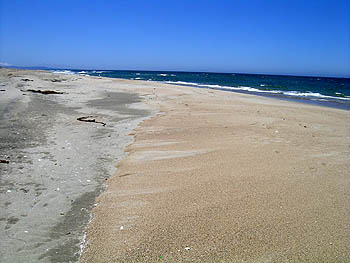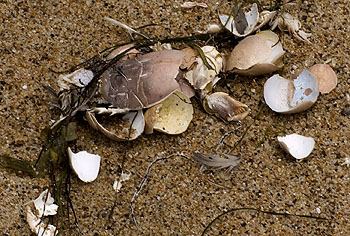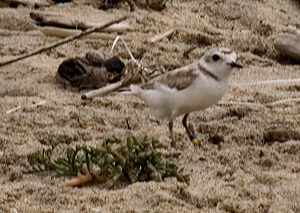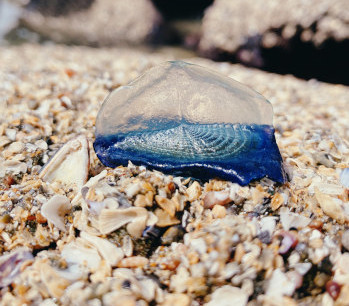
|
|||||||||||||||
|
| |||||||||||||||
Beaches and dunes begin to recover from winter storms  As spring progresses, smaller waves carry sand toward shore in waves (also known as sand bars). When one of these "waves" of sand arrives at the beach, it merges on to the existing beach. In this photo, you can see where a large wave of sand has flowed over the low, winter beach (fine gray sand) in a layer of coarse, reddish-brown sand. (Source: Kim Fulton-Bennett) By March, after four months of scouring by winter storm waves, most sandy beaches on the Central Coast are flattened and seriously depleted of sand. Winter waves have carried most of the sand offshore to form extensive underwater sand bars. As winter storms become less frequent, however, these sand bars start to migrate back toward the beach, marching slowly across the sea floor like underwater sand dunes. If the waves remain small for several weeks, the first of these migrating sand bars may actually reach the beach, eventually moving up onto the foreshore and welding itself onto the "berm" (the seaward edge of the beach where the sand begins to slope steeply down to the water). After severe winters, some beaches may be so flat that no berm exists. In this case, sand bars moving toward shore begin to recreate the berm. This process of sand bars moving ashore and rebuilding the beach continues sporadically throughout the spring and summer, but can be reversed any time, if late storms bring large, steep waves that sweep the sand back offshore. Although the strong northwest winds of spring sometimes create wind waves that erode the beaches, these same winds also carry beach sand to the back of the beach, out of reach of all but the largest storm waves. In this way, the spring winds help build up dunes that may have been eroded by winter storms. This process is especially effective when afternoon low tides coincide with peak afternoon winds, exposing wide expanses of sand to the full force of the wind. Dune plants begin to recolonize eroded areas Even on exposed beaches, where the northwest wind blows directly in from the sea, little eddies often form where the wind encounters the vertical faces of sand dunes that were eroded by winter storms. Within these eddies, winds may be slightly weaker, allowing sand to collect in low mounds just seaward of the existing dune line. Blowing sand also collects around storm-wrack, driftwood, and other debris at the back of the beach. As this debris decomposes (with the help of beach hoppers and sand flies), it adds organic material in the otherwise sterile beach sand. As the spring progresses, these low, sandy mounds act as miniature "raised beds" for dune plants. Seeds or fragments of dune plants such as sea rocket sprout within the low mounds, especially following late winter rains. Those dune plants that have survived the winter put on new growth in spring. As the drying northwest winds of spring become more persistent, some dune plants will store moisture in fleshy roots or stems. This allows them to continue to grow rapidly throughout the spring, which is essential if they are to keep their foliage above the drifting sand. Mole crabs move ashore as beaches expand Just as the winter storms begin to subside and beaches begin to rebuild, mole crabs (Emerita analoga) begin to return to the beaches in large numbers. Some of these are adult mole crabs that moved offshore (along with the sand) during winter storms. Others are tiny mole-crab larvae have been drifting at sea as larvae ever since the previous October. The first wave of these 1/8-inch-long mole-crab "megalops" larvae typically arrives on Central Coast beaches in late February or March, just as upwelling begins. At this stage, their bodies are essentially transparent, and they still have feathery swimming legs. These adaptations to the open ocean will be lost as they molt and develop into juveniles over the next month. Although the first large pulses of mole-crab larvae typically arrive at beaches in early spring, additional waves of mole-crab larvae will continue to arrive throughout the spring and summer. Note: Mole crabs at Bodega Bay typically begin to colonize beaches in April, about a month later than those on the Central Coast. Feasting on the small diatoms that bloom in early spring, the young mole crabs grow rapidly. Whenever spring upwelling results in a diatom bloom, the mole crabs will feed like crazy and put on a growth spurt. In order to grow, the young mole crabs must molt, shedding their old shells. Thus, you can often see masses of mole-crab shells littering the high-tide line on the day after a spring diatom bloom reaches a particular beach. Such diatom blooms are likely to occur several days after a period of strong northwest winds. When the mole-crab larvae are about 1/4-inch-long they change from being larvae to being juveniles, and their shells acquire a bluish tint. In older juveniles (1/2 to 3/4 inch long), the shells gradually change to tan and then gray in color. By May the first wave of mole crabs will already be mating and carrying eggs. Like the krill that support much of the life in offshore waters, mole crabs live in large, locally dense patches and provide essential food for a wide variety of mid-level carnivores, such as perch, surf scoters, and shore birds. Even the cast off shells and other body parts of mole crabs provide the primary source of food for at least two different beach animals--Excirolana isopods (tiny, pill-bug-like animals that live just above the swash zone) and spiny mole crabs (which look like "regular" mole crabs, but grow up to three inches long and live farther offshore, in the surf zone).  Beach wrack and molted mole-crab carapaces provide for food for Excirolana isopods and spiny mole crabs (note carapace of the spiny mole crab at middle left). (Source: Kim Fulton-Bennett) Spiny mole crabs In addition to the smallish mole crabs that live in and around the swash zone, a second, much larger type of mole crab lives just offshore, in and just outside of the surf zone. These spiny mole crabs (Blepharipoda occidentalis) are much larger, growing up to two or three inches long. The sharp, stiff spines on their carapaces presumably help protect these crabs from surf-zone predators, such as barred surf perch. Spiny mole crabs eat a variety of debris that is carried by wave action just above the sandy sea floor. However, their main food source is the cast off carapaces of other mole crabs, especially the smaller species. Sometimes you can find the molted shells of spiny mole crabs washed up on beaches a few days after lots of molted carapaces from smaller Emerita mole crabs show up on a baech. Possibly the larger, deep-water mole crabs eat so many of the smaller crabs' shells that they too undergo a growth spurt. In theory, then, the following progression of events could occur repeatedly during the spring months: Northwest winds -> upwelling -> diatom blooms -> mole-crab molting events -> spiny mole crab molting events. Sanderlings congregate and hunt mole crabs Just as the first mole crab larvae arrive on Central Coast beaches in March, so do the first migrating flocks of sanderlings. Some of these small, scurrying shorebirds spend the winter on the Central Coast. Many more are migrating up the coast, heading for their nesting areas in the Canadian Arctic. Sanderlings on Central Coast beaches eat mostly mole-crab larvae and small juvenile mole crabs. They also eat two species of beach isopods, Excirolana linguifrons and Excirolana chiltoni, which live in the wet sand along with the mole crabs. At higher tides, they may move up the beach and look for beach hoppers (amphipods). In March, huge migrating flocks of sanderlings sometimes gather on Central Coast beaches to feed at low tide. Although flocks of a few dozen sanderlings can be found much of the year (from July to April) on the Central Coast, these spring flocks can include hundreds or even thousands of hungry birds. These large flocks of sanderlings actively seek out the densest patches of mole-crab megalops larvae, which are typically found in the mid-tide zone, six to 18 inches above mean lower low water. A flock of sanderlings may consume half the mole-crab larvae in a dense patch before moving on to another area. However, they tend to avoid less dense patches of mole crabs, so they don't wipe out the entire population of a region. As noted above, mole-crab larvae begin to colonize Northern California beaches about a month later than they colonize beaches along the Central Coast. Sanderlings apparently take advantage of this delay, following the "wave" of spring mole-crab settlement events as they migrate up the coast. Interestingly, out in the open ocean, blue whales use a similar strategy when they hunt krill, migrating northward up the coast in late summer, and arriving at each major feeding area just as the local krill are reaching peak size and abundance. Snowy plovers seek nesting sites  Snowy plovers are so small that they can hide behind tiny dune plants or pieces of driftwood. (Source: Kim Fulton-Bennett) At the same time as migrating sanderlings gorge themselves on Central Coast beaches, another small shore bird, the snowy plover (Charadrius alexandrinus nivous), begins looking for nesting sites. Snowy plovers look similar to sanderlings, but are even smaller. Unlike sanderlings, snowy plovers are year-round residents on the Central Coast, and spend most of their time on the dry sand of the upper beach, hunting beach hoppers or hiding behind bits of beach debris. These endangered birds typically nest on Central Coast beaches from March through July. Unfortunately, their nesting activity is often disturbed by human beach-goers, dogs, or other predators. You can read more about them in April. By-the-wind sailors wash ashore One of the more dramatic signs of spring on the Central Coast is the mass-stranding of small, oval jellies known as "by-the-wind sailors" (Velella velella). The first waves of these jellies typically arrive in late March or early April, just after the first upwelling events of the year.  Velella velella jellies often wash up on Central Coast beaches when winds and currents shift in spring. (Source: Alex Wang/Wikimedia) Velella spend most of their lives drifting around the surface waters of North Pacific. If you pick up a stranded Velella (it's stinging cells are not strong enough to penetrate your skin), the first thing you will notice is its clear, flexible "sail." Because this sail runs diagonally across the Velella's body, the jelly can sail across the ocean surface at an angle of about 45 degrees to the right of the wind instead of simply being blown straight downwind. By sailing to the right of the wind, Velella normally avoid being carried toward shore, but instead tend to congregate near the center of the North Pacific Gyre, where winds and currents are often light (an area made famous in recent years as "The Great Pacific Garbage Patch"). However, seasonal changes in winds and currents, especially in spring, sometimes cause Velella to drift toward the coast, where they wash ashore by the millions. It is not exactly clear what causes these spring Velella strandings. Some researchers have suggested that Velella are most likely to wash up during the first period of strong northwest winds in spring. However, I have seen Velella appear in March or April even when winter storms persist into spring and upwelling starts later than usual. Other researchers claim that Velella wash ashore following periods of strong south or west winds, but such winds are rare during the spring upwelling season. Still others say that the stronger winds of spring overwhelm Velella’s sails and push them directly downwind (and thus toward shore). Personally, I have noticed that Velella strandings often coincide with the arrival of large amounts of flotsam--glass and plastic bottles, logs, chunks of Styrofoam, and large globs of weathered, hardened oil. In many cases, this debris has been colonized by sizable barnacles, which suggests that it has floating on the sea surface for months. This makes me suspect that the Velella (and trash) strandings are caused by changes in ocean currents rather than (or as well as) winds. For example, strandings might be related to the strengthening, shoaling, and shoreward movement of the California Current that occurs in early spring When not stranded and dying on a beach, Velella live at the surface of most of the world's oceans, feeding on small zooplankton, including fish eggs and larvae. I find it interesting that Velella appear in Central Coast waters at just the time of year when fish eggs and larvae are most abundant. Perhaps the Velella are feeding on fish eggs and larvae that are carried offshore from the coast by upwelling currents. If this hypothesis is correct, then those Velella that do not die on the beach might be using the Central Coast as a seasonal feeding area, just as many seabirds and marine mammals do. Since zooplankton are often scarce or occur in widely spaced patches in the open ocean, Velella have found an ingenious way to survive lean periods. They carry colonies of green algae, like little kitchen gardens, within their transparent bodies. The green algae harvest energy from the sun and the Velella somehow absorb nutrients from the algae. The pigments that make Velella tentacles blue may help protect their internal algae from being damaged by too much sunlight. |
